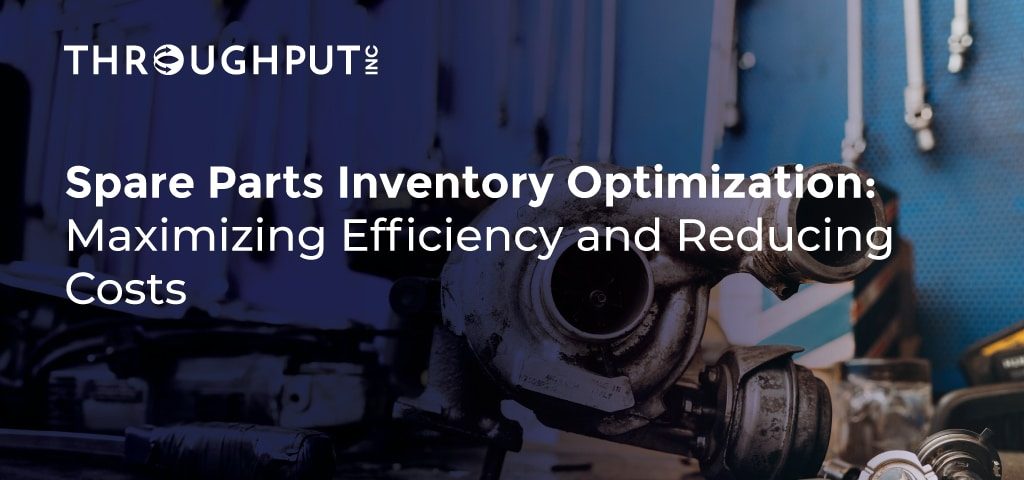In today’s fast-paced industrial landscape, managing spare parts and MRO (Maintenance, Repair, and Operations) inventory is more than just keeping shelves stocked. It’s about strategic optimization—ensuring availability while minimizing waste and costs.
With effective Spare Parts Inventory Optimization, businesses can strike a balance between availability and cost, ensuring seamless operations without overburdening budgets.
Why Spare Parts Inventory Optimization Matters?
Spare parts inventory optimization is essential for keeping operations smooth and cost-efficient. Poorly managed inventory leads to excessive holding costs, increased downtime, and wasted resources. A structured approach helps businesses:
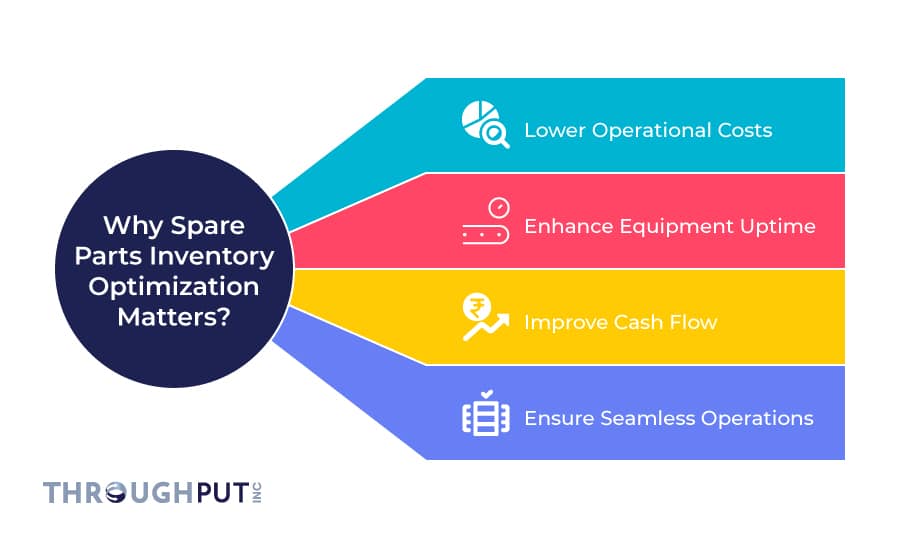
- Lower operational costs by eliminating unnecessary stock.
- Enhance equipment uptime with readily available critical spares.
- Improve cash flow by reducing capital tied up in inventory.
- Ensure seamless operations through demand-driven stocking.
Challenges in Spare Parts Inventory Management
- Excess stock leads to high storage and capital costs.
- Stockouts result in operational downtime and loss of productivity.
- Obsolete parts increase waste and inefficiency.
- Lack of visibility causes duplication and mismanagement.
- Supply chain disruptions create uncertainty in procurement.
What are the Key Strategies for Spare Parts Inventory Optimization
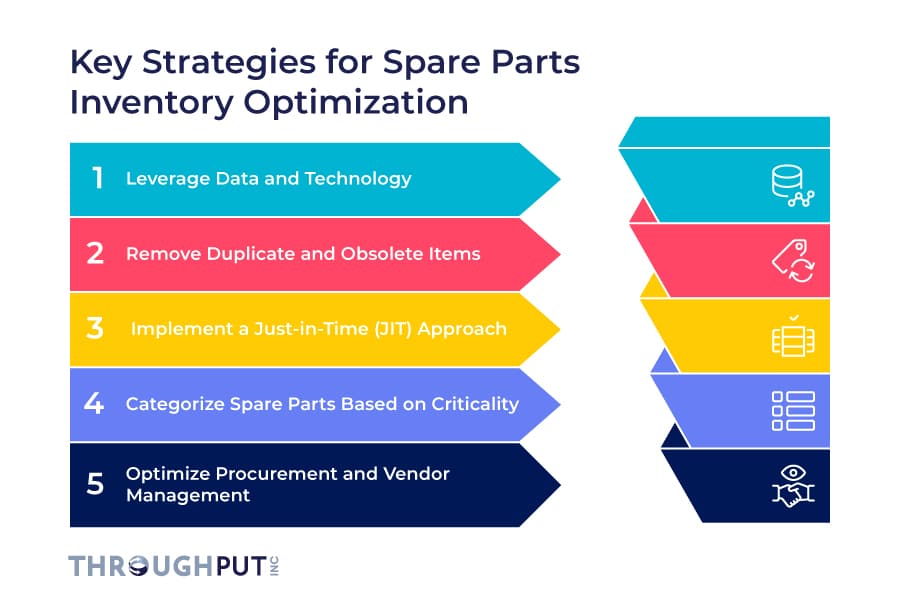
1. Leverage Data and Technology
Using AI-powered tools and data analytics helps in:
- Identifying slow-moving and obsolete inventory.
- Forecasting demand based on historical data.
- Automating reorder processes to avoid stockouts.
2. Remove Duplicate and Obsolete Items
- Conduct a periodic inventory audit.
- Use AI tools to identify duplicate SKUs.
- Remove obsolete parts to free up storage space.
3. Implement a Just-in-Time (JIT) Approach
- Reduce excessive stocking while ensuring availability.
- Collaborate with reliable suppliers for on-demand delivery.
4. Categorize Spare Parts Based on Criticality
- Critical parts: High-priority items required for essential operations.
- Operational spares: Needed for preventive maintenance.
- Non-essential spares: Can be ordered as required.
5. Optimize Procurement and Vendor Management
- Work with multiple suppliers to mitigate risks.
- Negotiate long-term contracts for cost efficiency.
- Evaluate vendor performance regularly.
MRO Inventory Optimization: Best Practices
What is MRO Inventory?
MRO (Maintenance, Repair, and Operations) inventory includes all the tools, equipment, and spare parts needed for maintaining operations. Effective MRO Inventory Optimization minimizes downtime and reduces excess holding costs.
Common MRO Inventory Challenges
- Unplanned downtime due to lack of critical spares.
- Overstocking of non-essential items.
- Inefficient tracking of parts.
- High procurement costs due to emergency purchases.
How to Optimize MRO Inventory Using AI Solutions?
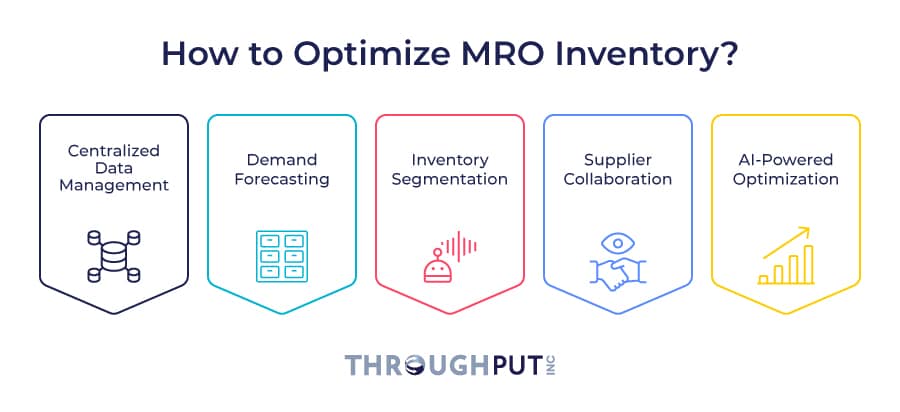
1. Centralized Data Management
- Integrate ERP, CMMS, and inventory management software.
- Maintain a single source of truth for all inventory data.
2. Demand Forecasting
- Use AI-driven predictive analytics to estimate part consumption.
- Implement automated replenishment systems.
3. Inventory Segmentation
- Categorize MRO parts based on consumption, cost, and criticality.
- Establish reorder levels for essential items.
4. Supplier Collaboration
- Develop strategic partnerships for efficient procurement.
- Use consignment stocking models for critical spares.
5. AI-Powered Optimization
- Automate reorder and replenishment with smart algorithms.
- Detect demand fluctuations and adjust stocking policies accordingly.

MRO Inventory Management: A Proactive Approach
What is MRO Inventory Management?
MRO (Maintenance, Repair, and Operations) Inventory Management is the strategic process of monitoring, stocking, and replenishing spare parts, tools, and consumables required to keep machinery and equipment running efficiently. Unlike production inventory, MRO inventory supports daily operations and maintenance activities, helping prevent unplanned downtime and operational disruptions.
By taking a proactive approach, organizations can strike the right balance between availability and cost, ensuring that critical components are always on hand—without overstocking.
What are The Key Benefits of Effective MRO Inventory Management
- Minimized Downtime: Ensure critical spare parts are available when needed, reducing maintenance delays and avoiding costly production halts.
- Reduced Carrying Costs: Eliminate unnecessary inventory build-up and free up valuable working capital tied to idle stock.
- Boosted Workforce Productivity: Equip technicians with immediate access to essential tools and materials, streamlining repair and maintenance workflows.
- Enhanced Compliance: Maintain accurate records and stock levels to align with safety regulations and industry standards.
What are the Steps to Improve MRO Inventory Management
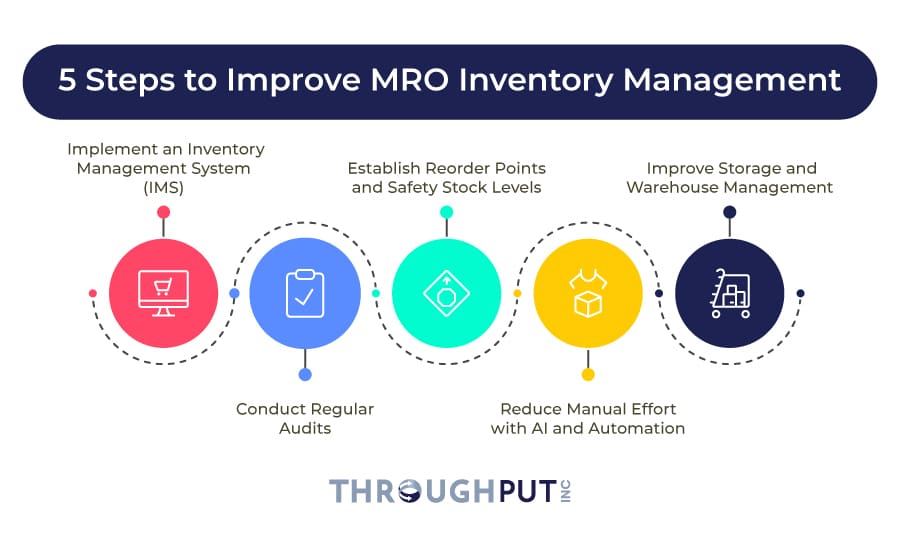
1. Implement an Inventory Management System (IMS)
- Choose a cloud-based IMS for real-time tracking.
- Automate stock updates and reorder alerts.
2. Conduct Regular Audits
- Perform periodic inventory checks.
- Identify slow-moving and obsolete items.
3. Establish Reorder Points and Safety Stock Levels
- Set minimum and maximum inventory thresholds.
- Use historical data to determine optimal stock levels.
4. Reduce Manual Effort with AI and Automation
- Utilize AI-powered platforms for inventory optimization.
- Minimize errors and inefficiencies in stock tracking.
5. Improve Storage and Warehouse Management
- Use RFID and barcode scanning for better tracking.
- Organize storage based on part criticality and usage frequency.
How ThroughPut.AI Helps with Spare Parts and MRO Inventory Optimization?
ThroughPut.AI offers advanced AI-driven Spare Parts Management Software to enhance Spare Parts Inventory Optimization, MRO Inventory Optimization, and MRO Inventory Management.
ThroughPut.AI accelerates spare parts and MRO inventory optimization by leveraging AI and machine learning to:
- Predict demand and optimize inventory levels to reduce excess stock and shortages.
- Analyze real-time and historical data to track parts usage, expected supply lead times, and supplier reliability.
- Dynamically rebalance inventory across thousands of locations to ensure availability of critical spares.
- Automate replenishment and identify working capital reduction opportunities while maintaining operational continuity.
How ThroughPut.AI Works
Step 1: Data Integration
ThroughPut.AI gathers data from disparate systems—including inventory records, purchase orders, requisition data, and transactions—to create a holistic view of global parts inventory.
Step 2: Intelligent Prioritization
The AI-driven platform prioritizes spare parts based on actual maintenance needs, stock levels, and real lead times, reducing inefficiencies in procurement and storage.
Step 3: Predictive Optimization
By analyzing historical maintenance data, ThroughPut.AI predicts future requirements, optimizes schedules, and maximizes asset uptime, ultimately extending equipment lifespan while minimizing costs.
Key Features of ThroughPut.AI
- AI-powered prediction of parts demand and location needs.
- Automated predictive replenishment to minimize stockouts and overstocking.
- Supplier ranking based on key performance factors.
- Real-time data-driven decision-making for inventory adjustments.
- Enhanced working capital management with optimized stock levels.
Benefits of ThroughPut.AI’s AI-Driven Optimization
- Maximum output at optimized inventory levels.
- Greater planning reliability and fewer stock shortages.
- Reduced working capital spend and minimized waste.
- Elimination of maintenance bottlenecks and asset downtime.
Why Choose Throughput.AI?
- AI-Powered Supply Chain Analytics: Gain real-time insights into inventory performance.
- Automated Inventory Optimization: Reduce excess stock and eliminate waste.
- Predictive Maintenance: Ensure availability of critical spares.
- Seamless Integration: Works with existing ERP and CMMS systems.
Final Thoughts
Optimizing spare parts and MRO inventory is essential for maximizing operational efficiency and minimizing costs. With AI-driven solutions from ThroughPut.ai, businesses can streamline inventory management, reduce waste, and ensure seamless maintenance operations.

FAQs – Spare Parts and MRO Inventory
1. How much working capital can I free up by optimizing spare parts and MRO inventory?
Most organizations can free up 10–30% of their working capital by implementing AI-driven spare parts and MRO inventory optimization. ThroughPut.ai helps enterprises identify obsolete, slow-moving, and overstocked items using predictive analytics and real-time demand insights.
By aligning inventory levels with true maintenance needs, you reduce carrying costs and free up significant capital that can be reinvested into operations or innovation.
2. What ROI can I expect from investing in your spare parts optimization solution, and in what timeframe?
Companies using ThroughPut.ai typically achieve ROI within 6–12 months, driven by reduced stockouts, lower working capital, and improved equipment uptime.
Our AI-powered MRO optimization software provides visibility into parts demand, usage trends, and replenishment cycles — helping your teams make smarter decisions faster.
The outcome: reduced carrying costs, fewer emergency purchases, and up to 25% improvement in spare parts availability.
3. How does your solution reduce unexpected downtime and maintenance disruptions?
ThroughPut.ai leverages real-time data and predictive analytics to ensure that critical spare parts are always available before failures occur.
Our solution continuously monitors equipment health, demand variability, and supplier lead times to predict potential shortages or failures in advance.
This proactive approach minimizes unplanned downtime, improves asset reliability, and enhances maintenance planning accuracy — helping you maintain operational continuity and reduce costly disruptions.
4. Can your system integrate with our existing ERP, CMMS, or legacy systems?
Yes. ThroughPut.ai integrates seamlessly with major ERP, EAM, and CMMS systems such as SAP, Oracle, Maximo, and Infor.
Our platform extracts and harmonizes data from multiple sources to create a unified, real-time view of your spare parts and MRO inventory.
This means you can optimize existing operations without replacing your current infrastructure — enabling data-driven decision-making across procurement, maintenance, and supply chain teams.
5. How do you determine which spare parts are “critical,” “operational,” or “non-essential”?
ThroughPut.ai uses AI-based classification models that analyze historical consumption, part criticality, supplier lead time, and cost impact.
This helps identify which parts are mission-critical for uptime and which are non-essential or overstocked.
Our advanced spare parts optimization engine then recommends right-sized stock levels and reorder frequencies, ensuring a balance between availability and cost efficiency.
6. What happens in case of supply chain disruptions (e.g. supplier delays, logistics delays)?
ThroughPut.ai provides real-time visibility into global supplier performance and logistics bottlenecks.
Using AI-driven simulations, the system dynamically re-optimizes MRO inventory to protect against delays — suggesting alternative suppliers, expedited routes, or adjusted reorder quantities.
This allows your business to maintain operational resilience and avoid costly downtime, even during major supply chain disruptions.
7. How do you ensure that the optimization model remains valid over time (i.e., as demand patterns change)?
ThroughPut.ai’s machine learning models continuously learn from new demand signals, consumption data, and maintenance patterns.
This ensures your MRO optimization model remains accurate even as production schedules, asset lifecycles, or supplier conditions evolve.
Our adaptive AI eliminates the need for manual recalibration — keeping your inventory lean, agile, and up to date with real-world performance.
8. What is the implementation timeline and what organizational resources will be required?
Typical implementation for ThroughPut.ai’s spare parts and MRO optimization software takes 8–12 weeks, depending on data quality and scope.
We handle data integration, model setup, and pilot testing — requiring minimal IT involvement.
Your maintenance and procurement teams participate in validation workshops to align outcomes with business goals.
9. How do you measure success after deployment? What KPIs should we track?
We track key operational and financial KPIs to measure optimization success:
- Working capital released (%)
- Spare parts availability rate
- Inventory turnover ratio
- Obsolescence and stockout reduction
- Downtime prevention and maintenance efficiency
ThroughPut.ai’s dashboard gives you real-time visibility into every KPI, ensuring data-backed performance reporting for C-suite leaders.
10. Is your pricing model subscription-based, or do you charge per saved value / performance?
ThroughPut.ai offers flexible pricing models — including subscription-based and outcome-based options — depending on your scale and business goals.
Our pricing aligns with measurable value: you pay for performance improvements, not just software licenses.
This ensures full accountability and a transparent ROI from your MRO and spare parts optimization investment.

